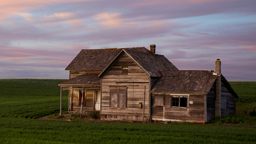A grizzled journeyman carpenter once told me a secret: You have to make things square and level, he said, and there’s just no getting around that. But carpentry isn’t the be-all and end-all when it comes to home improvement. Take painting, for instance. No matter how good you are at squaring, leveling and other carpentry skills, a bad paint job can make even an architectural masterpiece look like an elementary school art project. The following are some tips for making sure that last piece of the puzzle – a professional-looking coat of paint – fits snugly into place.
Take a Piecemeal Approach
My old house had a coat of something called “Georgian Silver” in the family room that suspiciously resembled baby blue, one of my least favorite colors. Ditto for the so-called “Adobe” that turned my living room into – yech – light pink. For many DIYers, the likelihood of successfully translating the little color square on the paint can to the finished wall color feels about the same as your chances of matching your fortune cookie numbers to the winning lottery ticket.
Instead of rolling the dice with a full bucket of paint and a day or more of your time, consider buying samples and applying them to a primed 4x4- foot piece of drywall at home. Prop the painted sample piece in various parts of your cabin’s room during different light conditions. If it looks good, try painting the middle portions of one wall (don’t bother with the edges) to see if that first impression holds up.
Sound like too much monkeying around? Companies like Benjamin Moore and Valspar have websites where you can play with thousands of different paint combinations. You can also buy paint samples for checking out promising colors and finishes.
Side-to-Side, Daniel-san?
Mr. Miyagi might have known his karate, but he never would have run a successful painting business. For a smooth finish, you can’t just start that swipe at one end and continue on to the other end of your reach. Starting a paintbrush stroke like this will lead to paint ridges, or little dollops of paint that show up when the paint dries. To avoid this, start your strokes in a bare spot and then work into the already painted area, feathering the painted portions together with brush strokes that have lower amounts of paint. This approach works for both side-to-side and up-down movements; just make sure you don’t start – or stop – your brush at the end of the stroke to avoid those unsightly ridges of paint. Hi-yah!
Preserve Those Brushes
Dried, crusty brushes are useless, and cleaning them each time you take a break is tedious. You don’t have to completely clean your brushes, though; simply shake the excess paint from the bristles, and then seal the brush in a plastic bag. If you wrap the brush in a damp cloth and store in a cool place out of direct sunlight, this simple trick will save you lots of time and hassle – and more than a few brushes. Re-use any stored brushes within a few days for best results.
Take the Shine Off
Most people know you need to sand a flaky wall, then wipe it clean and prime the bare areas. But the same holds true if you’re painting a surface with a high-gloss finish. These shiny walls, valued for both their appearance and resistance to staining, also don’t take kindly to new paints. Lightly sand these finishes with no-load sandpaper (which resists clogging) then wipe them clean with a water/TSP (tri-sodium phosphate) solution.
You Need a Good Nap
Rollers are by far the preferred method for covering large flat areas of wall or ceiling. The standard method for applying paint on these large areas is by applying a big W, then covering the unpainted areas with remaining strokes, being sure to overlap into the “W.” The pile, or length of the “fuzz” in the rollers is referred to as the nap, and the type of nap you choose is just as important as the rolling method. For smoother areas that require a smooth finish, use a shorter nap (5 to 10 millimeters). A longer nap will give your wall a more textured finish, and they also hold more paint – ideal for covering larger areas.
Get Properly Loaded
Loading simply means filling the brush or roller with paint, but overloading your roller or brush is one of the most common painting mistakes. The trick is to get just enough paint into the roller or brush to cover a decent area, without having to re-dip every 10 seconds. We’ll assume you’re working with latex paint (oil- or alkyd-based paints are the choice of professionals, but are a little trickier to work with and dispose of ). Before you begin, condition the rollers or brush with a little bit of water (for latex paints) or paint thinner (for oil-based), then spin or shake out the excess.
Next, get some paint on the wetted roller and work it back and forth until the roll is saturated but not drippy. For brushes, immerse no more than two-thirds of the brush into the paint, then press out the excess on the side of the can.
Coupled with a properly deployed drop cloth, proper loading also works wonders for reducing splatter.
These few tricks will go a long way toward making painting at the cabin a much smoother and cleaner experience. Just take your time, choose your paint and painting equipment wisely, and you can use that first brush stroke to blot out the “Painters for Hire” section in the yellow pages.
Kurt Anderson is a freelance writer and DIY painter who has been known to paint vast sections of his houses in colors he can’t stand.
 Sebastian Czapnik, dreamstime.com
Sebastian Czapnik, dreamstime.com 









